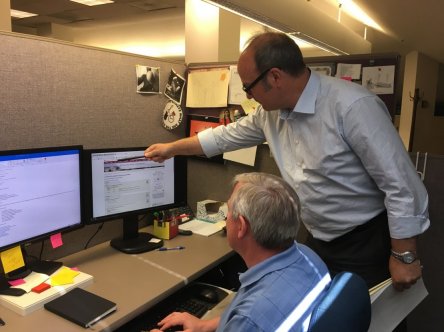Elaine wrote the following article for the Minnesota IT Services blog on accessibility issues. She is a librarian at the Legislative Reference Library and also serves as the Accessibility Coordinator for LNET (Legislative Networking Group).

The Minnesota Legislature’s website is the unified effort of staff from the House and Senate and several joint legislative offices including the Revisor of Statutes, the Legislative Reference Library, the Legislative Auditor, and other offices within the Legislative Coordinating Commission. Legislative staff from the various offices collaboratively manage the website through the LNET (Legislative Networking Group).
LNET manages the content and design of the Legislature’s website and acts as a forum for all legislative offices to share and discuss issues. The group meets year-round to continuously improve usability and content on the legislative web pages. LNET members act as consultants for one another on issues of technology.
While each body and office manage distinct websites, many legislative website activities are collaborative. Offices share data to make pages that include information from multiple offices, such as the combined calendar, the conference committee page, and MyBills.
Much of the Legislature’s website, which consists of web pages and PDF documents for download, is compliant with the state accessibility standards and many of its documents posted from 2017 to the present are accessible, or the information is provided in an alternative accessible format such as HTML. Like many organizations, large amounts of older materials may not meet accessibility standards and may require a large dedication of resources if the older material is to be remediated. Legislative staff continue to work toward increasing the accessible online presence of the Minnesota Legislature’s website.
The website is coded so that it is usable by keyboard and with a screen reader, which includes use of jump navigation, alt text, heading tags, and meaningful link language. The Legislature uses popular tools such as WebAIM’s WAVE to test for accessibility. IT staff from the legislative offices are currently coordinating to transition the website to Bootstrap, a web interface framework, that will improve the way it works on diverse screen sizes.
Many materials, such as bills, session laws, statutes, and rules, are available in HTML as an alternative to PDF. Several legislative offices publish reports and use CommonLook software to remediate PDFs, when applicable. Tagged PDFs are offered when possible. Because the nature of legislative work is complex, fluid, and fast-paced, tagged PDFs may not be immediately possible. An additional accessibility challenge for the Legislature is that some documents that are submitted for posting come from public citizens or non-legislative entities and are not electronically accessible. For specific documents that may not be accessible, the Legislative Coordinating Commission facilitates requests for remediation to make the documents accessible.
Audio and video archives are continually expanding on the Legislative website. Streaming video programming is captioned in both the House and Senate. Recent Senate video files have searchable captions. In addition, the House is exploring ways to possibly make transcripts of audio files available.